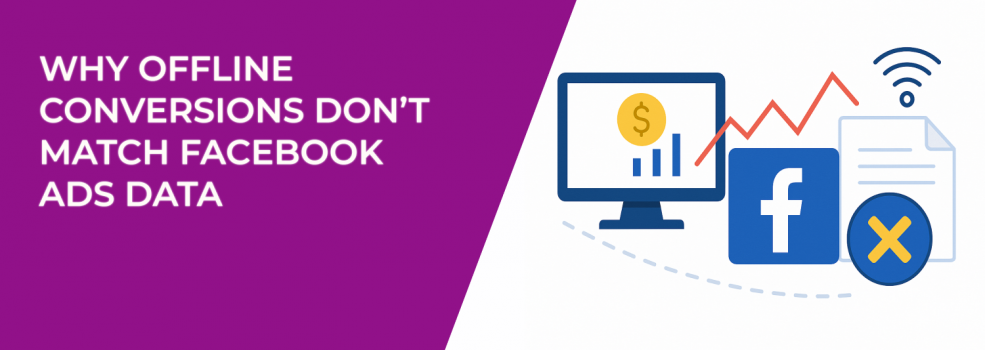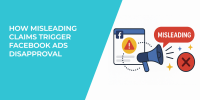You check your CRM. A bunch of new customers came in last week. Then you check Facebook Ads Manager — and only a few conversions show up.
So what’s going on? Where’s the rest of your data?
If your business gets a lot of leads or sales through phone calls, in-person visits, or follow-up meetings, Facebook may not be able to track those actions. That’s why the numbers in Ads Manager and your real results often don’t match.
Let’s walk through the main reasons this happens and how you can fix it.
What Are Offline Conversions?
An offline conversion is when someone takes action after seeing or clicking your Facebook ad — but the action happens off the internet.
Here are a few common examples:
-
A person calls your business after seeing your ad.
-
They visit your physical store and make a purchase.
-
They attend an in-person event you promoted online.
-
They become a customer after a meeting or sales call.
Facebook doesn’t automatically track these actions. If you want them to show up in your campaign results, you have to send that data back to Facebook manually or through an integration. But even then, your numbers might still be off.
1. Facebook Uses a Short Attribution Window
Facebook gives credit to an ad only if the person converts within a specific time window — usually 7 days after clicking or 1 day after viewing the ad.
Here’s what that means:
-
If someone clicks your ad and buys 2 days later, Facebook will count it.
-
If they buy 10 days later, Facebook probably won’t count it.
-
If they just saw your ad (but didn’t click) and buy 3 days later, that won’t count either.
Many businesses — especially those with longer sales cycles — miss out on tracking real results just because the sale happened a bit too late. This is common in industries like real estate, education, or anything with higher-priced products or services.
So even if your ad helped bring in the sale, it might not show up in the report.
2. Your Uploaded Data Might Be Missing Key Info
When you send offline conversions to Facebook, it tries to match each conversion to a person who saw or clicked your ad. But for that to work, it needs certain details.
You should include:
-
The full name of the customer.
-
Their email address and/or phone number.
-
The date and time they took the action (like when they made the purchase).
-
What kind of event it was — for example, a sale, call, or appointment.
-
The value of the event (like how much they spent), if possible.
If any of this is missing — or written in the wrong format — Facebook might not be able to match it. And if it can’t match it, it won’t show the conversion in your campaign results.
That’s why it’s important to double-check your data before uploading. Even small things — like using capital letters in emails or leaving out a country code — can cause problems.
3. Facebook Only Sees the First Step
Let’s say someone clicks your ad and becomes a lead. Then:
-
A few days later, they get a call from your sales team.
-
They attend a demo the next week.
-
They finally buy your product a month later.
Facebook usually only sees that first step — the click and lead form. Everything after that happens outside of Facebook, unless you track it manually.
So if you're judging your campaign based only on what Facebook shows, you're missing the bigger picture. That sale a month later? It wouldn’t be credited to the ad, even though the ad started the whole process.
To connect the dots, you can add UTM tags to your landing pages and save them in your CRM. That way, when a sale happens later, you’ll still know the lead originally came from Facebook.
And if your Facebook ads are getting clicks but not sales, it might not be the ad itself — it could be the way you're tracking leads through the funnel. You can learn more about fixing that kind of problem in this guide: Facebook Ads Not Converting: How To Fix It.
4. Different Platforms Give Credit in Different Ways
Let’s say one customer:
-
Clicks your Facebook ad.
-
Then later clicks your email.
-
Then Googles your business and makes a purchase.
Which channel gets credit?
It depends where you're looking:
-
Facebook might say the ad caused the sale.
-
Google might say it came from search.
-
Your email tool might say it was the newsletter.
-
Your CRM might say it was a phone call.
Each platform uses its own rules for deciding what counts. This is called attribution — and it’s why your numbers often look different everywhere.
Instead of picking one platform to trust, try to look at the whole customer journey. Where did the lead first come from? What touchpoints influenced the sale? These are better questions than just “Which tool says I got a sale?”
5. Manual Errors in the CRM Can Break Tracking
Sometimes the problem is just human error.
Here are some common mistakes:
-
Someone enters the wrong date — so Facebook can’t match it.
-
A phone number is missing or formatted incorrectly.
-
The sale gets added to the CRM weeks after it happened.
-
The lead source is left blank or labeled incorrectly.
If you’re uploading conversions to Facebook from your CRM and they’re not showing up, it’s worth checking if the data is clean and consistent.
The best way to avoid issues? Use automation tools that sync your CRM data directly with Facebook’s Offline Events — no manual entry needed.
And if you want to improve your targeting and tracking from the start, you’ll want to understand how to reach the right audience on Facebook using better audience setups.
So, Who Should You Trust — Facebook or Your CRM?
The truth is, neither one tells the full story on its own.
-
Facebook sees what happens on its platform.
-
Your CRM sees the long-term customer relationship.
-
Google Analytics might show the last place they clicked.
Each tool gives you part of the truth.
So instead of trying to get them to match perfectly, focus on trends:
-
Are leads from Facebook becoming real customers?
-
Is your cost per lead going down or up over time?
-
Are certain campaigns sending more qualified leads, even if the conversions show up later?
These are the numbers that really matter when it comes to growing your business.
How to Get Better Results and Clearer Tracking
If you want your offline conversions to show up more accurately in Facebook, here’s what to do:
-
Match your reporting window to how long your sales usually take. For example, if your customers usually buy after 2 weeks, you may need to adjust how you view your results.
-
Use the right data when uploading conversions. This means names, emails, phone numbers, timestamps, and event values — all in the right format.
-
Automate your data uploads. Manual work leads to more mistakes. Use a tool that connects your CRM directly to Facebook’s Offline Conversions.
-
Track your UTM tags. Save the original ad source in your CRM, so you always know where a lead came from — even months later.
-
Look for patterns. One campaign might not show immediate sales, but over time it might bring in higher-value customers. That’s just as important.
Once you do this, you’ll start to see which ads are truly worth your budget — even if Facebook doesn’t give them full credit.
Final Thoughts
Offline conversions aren’t broken. They’re just harder to track.
Facebook Ads Manager gives you part of the story. Your CRM gives you another. But the real value comes from connecting the dots between them.
Once you understand how offline sales really flow from your Facebook campaigns, you’ll make better decisions, get more out of your budget, and stop worrying when the numbers don’t line up exactly.

